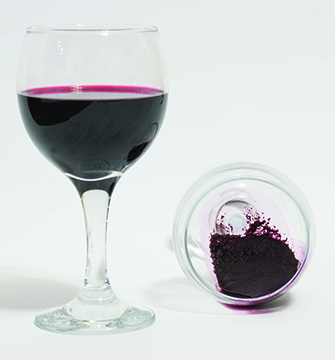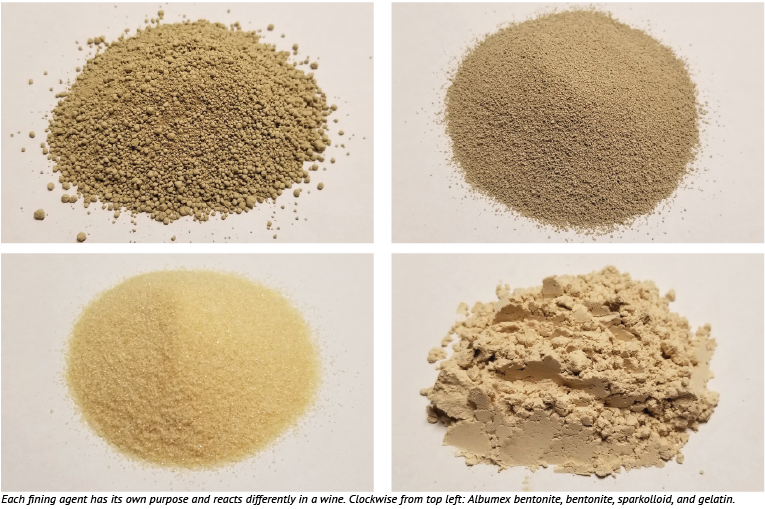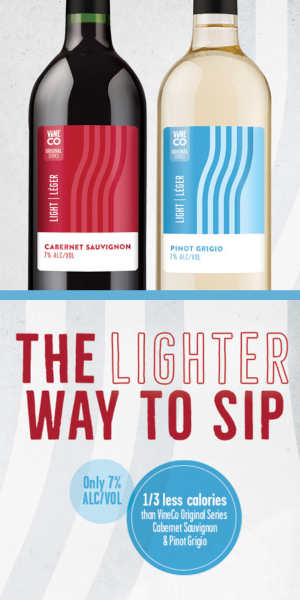
The goal for experienced and new winemakers alike is a product that is both pleasant in taste and appearance. Unfortunately for many new winemakers the result is stubborn cloudiness with sediment, or worse, a product that develops haze once bottled. A wine that is cloudy is considered a seriously flawed wine and thought to be a sign of shoddy, rushed winemaking practices, or just plain inexperience. This end result will be rejected by potential customers in a professional setting, and a major turnoff for friends and contest judges in the amateur setting. Juice from grapes and fruits used in country wines contains naturally occurring particles and compounds from which hazes can develop at various stages of the winemaking process. Cloudiness due to proteins, pectins, phenols (color pigments and tannin), and tannins from oak barrel aging are things that need to be addressed either by racking, fining, or filtration. Winemakers wanting to make early-drinking, crystal clear wines without waiting for them to clear naturally with time may want to consider the use of fining agents.
Fining agents are most often added to a wine after fermentation (although, sometimes they are added before) during the aging process to attract and settle out suspended particles. Even though fining takes more time and may not exactly reach the same level of clarity achieved with filtration, it makes for a significantly clearer and professional appearing final product than doing nothing at all and is much faster and more effective than time alone. This is especially desirable when the goal is to make early-drinking wines. Fining makes sense for home winemakers as it is an economical way to achieve a wine that shines without having to purchase filtration equipment. If you already own or are considering the purchase of a filtration unit, fining and filtration go great together. Fining and the use of pectic enzyme settle out larger particles, which makes for a more efficient filtration process closer to bottling.
Before we move on, we need to briefly address another form of sediment: Tartrate crystal formation. Tartrate crystals are a result of tartrate instability that present as sediment and look like fine glass shards. These crystal shards form and settle to the bottom of the bottle. This can occur after chilling a wine for a period of time if the wine has not been properly stabilized against it. The way to avoid this is to chill the wine down to around 23 °F (-5 °C) for a minimum of two weeks in a PET carboy. Tartrate instability, while not an issue of clarity, will put off (even alarm) someone about to consume the wine as they may think there are glass shards in the bottle. Plus, no one needs a crunchy surprise from the last pour of the bottle. The saying, “Good to the last drop” comes to mind here.
Fining Agents
There are many different fining agents available to home winemakers that are easy to use and are specific in their action. Fining allows one to alter the chemical stability of the wine by not only basic clarification, but also the reduction of harsh phenols (such as tannin, which can also affect clarity, causing sediments in the bottle), and the removal of haze-forming elements that cause instability. One particular haze-producing element is protein, which can form a haze later in the bottle even after the wine has been filtered. Choosing which fining agent is dependent on the action desired and the different particles present in the wine, most notably phenolic compounds. The chemical makeup and difference in processing red wine compared to white imparts a significant amount of phenolic content, which will require different fining agents to be used. Reds and whites aged in barrels will also have a higher level of tannin as oak can contain high levels of tannin. Red wine will have different needs than a typical un-oaked white wine. Tannin concentration is the most significant difference in the situation of clarification and may cause improper clarification with some fining agents, resulting in a cloudy wine or bottle sedimentation. The chemical and physical nature of each fining agent is also different. This variability allows the winemaker to tailor his or her fining agent to their particular situation.
Fining agents are typically added in the form of a slurry or liquid to be added to and evenly dispersed throughout the wine. Once the fining is added to the wine, it will react with or absorb components in the wine and will begin to settle to the bottom of the vessel. Finings like bentonite or sparkolloid (and others) carry a particular charge and attract the opposite charged particles. Once the collection of particles becomes heavy enough they will collect as sediment at the bottom of the vessel, allowing the winemaker to carefully rack the clean wine off the sediment after a period of time. Sometimes you can see results in a matter of hours. Fining is typically performed well after primary fermentation, after the first racking when most of the heavy suspended particles have settled out.
Care must be taken when using fining agents. Adding too much can have a negative effect on the wine such as the stripping of desired flavor components or even color. On the other hand, adding too little will not produce the desired result. The goal for fining agents is to assist the winemaker in producing a crystal clear wine, free of harsh flavors while minimally affecting the wine’s color or flavor. Choose the correct fining ingredient for your purposes and closely follow the manufacturer’s instructions. Manufacturers will make recommendations in reference to the amount needed. Bench trials are recommenced in determining the correct amount to achieve the desired result without affecting the wine in a negative way. Consider this process an investment of your time to ensure all future efforts will turn out well. To learn how to perform bench trials, digital members of WineMaker can read more about the process here: https://winemakermag.com/technique/performing-bench-trials.
Following is a list of the most common fining agents available to assist you in making a clear, brilliant wine. You will notice some are made from land- or sea-dwelling creatures while others are vegan-friendly options made of alginic acid salt (sparkolloid) or clay (bentonite). If a vegan option is what you are seeking, you should be able to find the right fining agent for the job. For more on wine for vegans, the Wine Enthusiast story “Is Wine Vegetarian, Vegan or Neither?” should shed some light on the subject: https://www.winemag.com/2018/05/09/vegetarian-vegan-wine/.
Note: You will see different instructions from the various online retailers for the fining agents in this article. Instead of getting into specific instructions for each, I recommend using the manufacturer’s instructions provided with the fining agent to adjust your wine.

Bentonite
Bentonite is a type of fine clay made of aluminum-silicate. It carries a negative charge that binds to particles with a positive charge. These particles then settle at the bottom of the vessel. Bentonite is recommended for white wines to inhibit haze caused by naturally occurring proteins. While less common, it can also be used in red wine, however it has the potential for stripping color. Although there can be a significant amount of deposit as a result of the fining process, it is a popular choice for winemakers, especially due to its minimal color reduction, which protects the winemaker from an accidental over fining. This gives it an edge over other fining agents. It works best when the wine is at warmer temperatures, after fermentation. It is also more effective at a lower pH because the positive charge on proteins is stronger at lower pH levels. Bentonite can also be added prior to fermentation to get a head start on the clarification process. When using it prior to fermentation, double the rate of addition being careful not to exceed the maximum dosage prescribed by the manufacturer. As with any fining addition, bench trials are recommended.
Another bentonite product available to home winemakers is Albumex bentonite. This can be used for protein stabilization alone in wines with a pH lower than 3.5. This is easier to use because it can be directly added to the wine without the overnight mixing process used with traditional bentonite. Simply dissolve it in cold water and add it to the wine. Apply at a rate of 1–3 g/L (4–12 g/gallon) of wine. In my wine cellar, bench trials generally indicate an addition in the middle of this range for my cold-climate whites leads to great success.
Sparkolloid
Sparkolloid is a very effective fining agent made of alginic acid salt and is popular with home winemakers. It carries a positive charge and attracts particles of a negative charge. Although it can be used with white wine, its primary function is for red wines. I have personally used this fining agent extensively to treat murky pear and apple wines with great success. Several manufacturers and online retailers suggest waiting only a week or two before racking off the sediment. However, in Daniel Pambianchi’s Techniques in Home Winemaking, he recommends allowing the wine to settle for up to six months before proceeding with filtration and bottling operations, as the sediment created is rather fluffy and easily disturbed without giving it more time to compact. In addition, intermittent rackings during this time can be performed along with sulfite testing and additions. For example, if you go to rack your wine after a sparkolloid treatment and you bump the table your carboy is sitting on, you might as well come back a few days later to try racking again. This fluffy sediment can also cause a significant loss of wine depending on the amount of suspended solids, particularly when using it in the higher addition rates. Pambianchi suggests a second fining agent recommended for red wines can be added one month after the initial sparkolloid addition in order to accelerate the fining process.
Casein
Casein is the principle protein in milk. It is typically used for fining and/or removing harsh compounds from whites by absorbing and settling out suspended particles. It can be used to reduce tannin levels in over-oaked white wines and to remove excess tannic harshness in over-extracted reds. It can also be used to reduce browning from oxidation (in which case you would double the dose of casein used). Color stripping is possible if excessive amounts of casein is used. The wine can be racked after a few days or within a week after initial treatment.
Gelatin
The primary function of gelatin, which is a proteinaceous fining agent made from animal tissue, is to bind to and settle out suspended particles and reduce excessive phenolic levels. Therefore it is primarily used in red wines. However, there are reports of gelatin being used to reduce the degree of phenolic compounds associated with bitterness, astringency, and browning in white wines. Because of the lack of tannin in white wine, gelatin may remove what little there is, and may not even be effective in removing suspended particles. Gelatin provides proteins that bind to the tannin. If used in excess, a major quantity of protein will be left in the wine leaving a haze (i.e. in white wines that are low in tannin). If used in this manner, a tannin addition can be made to avoid over-fining — tannin powder may be added at the rate of 10–30 g/hL (0.4 to 1.1 g/gallon) of wine, 3–5 days prior to the gelatin addition. Gelatin is a good choice for wines that underwent carbonic maceration as the tannin levels may be too high.1
Isinglass
Isinglass is a pure form of gelatin traditionally made from the air bladders of sturgeons (but because sturgeon populations are threatened in a number of regions today, other fish are often used). With its ability to clear wine in a very short time and its low color-stripping potential (compared to other protein-based fining agents like casein and gelatin) it is a very popular fining agent among home winemakers. Isinglass is recommended for white wines only. It can throw a heavy deposit and cling to the sides of the carboy making racking a bit of a chore. A second fining of bentonite can be used to help settle the sediment more effectively, and help prevent filter pad clogging issues if that is the next step in the process. However, racking the clean wine to another carboy before filtration can also be done if the second bentonite fining is not wanted. Because isinglass is derived from fish, it may develop a fishy odor, especially if it is stored warm. It is for this reason high-quality, fresh isinglass should be properly stored in a cool place. Liquid isinglass often has a shorter shelf life than the dry form.
Egg White
Egg whites have been used for fining red wines for hundreds of years and are still popular today. The albumen content in egg white can be used to remove phenolic compounds associated with harsh astringency by binding and reducing tannin content. Typically performed in the barrel or prior to bottling, fining in this manner leads to softening of the wine and increased suppleness. There is a potential risk of color loss, however it is minimized if proper fining and racking techniques are used.
In preparing egg whites for clarification, the egg white must be separated from the yolk and then added to salted water. The recommended dosage is 5–10 g/hL of wine, or 1–2 egg whites per 26 gallons (100 L). Alternatively, pure, refrigerated egg whites can be used. Typically, approximately 30 mL (2 Tbsp.) of pure egg white is the equivalent of 1 large egg white. For each egg white, a pinch of table salt should be dissolved in 100 mL of water and then combined with the egg white. Egg whites can be added to the wine directly into the barrel and mixed well. The wine should be racked in 1 to 2 weeks, no later.1
Kieselsol
An effective fining agent for both red and white wines, kieselsol is a silicate suspension that carries a negative charge. It binds to and settles out proteins. Kieselsol is great for sterilized or fresh juice, juice concentrates, or wines that did not undergo oak aging because it is specifically effective on wines with low tannin content. Kieselsol can be used in conjunction with gelatin for a more compact settling, making racking easier.
Kieselsol is also sold in two-step clarification mixtures called Super-
Kleer K.C., which is a dose of kieselsol and chitosan. Chitosan is a positively-charged fining agent made from chitin, a compound that makes up the exoskeleton of crustaceans, such as shrimp, crabs, and lobsters. The fining process works by creating both strong negative and positive charges in the wine, which allow for larger yeast clumping and faster clearing. Results can be seen in 12–48 hours. From experience, this particular fining agent works very well on my native grape varieties like Niagara white and Catawba, which can be tough to clear some years.
PVPP
Polyvinylpolypyrolidone (PVPP) is a synthetic polymer used to reduce the level of phenolic compounds associated with browning and astringency in white wines, as well as excessive bitterness in red wines. It is also efficient in preventing oxidative browning and removing brown by-products of oxidation from white wines, and can be used to remove pink coloration that will sometimes occur in Sauvignon Blanc. Typically, PVPP is used as a preventative measure to avoid these issues. PVPP is a gentle fining agent that preserves wine aroma, as opposed to some other fining agents.
Pectic Enzyme
Even though pectic enzyme is not considered a fining agent, we need to talk about its use since it is important in preventing a pectin haze later on. Pectic enzyme breaks down pectin, which is naturally present in fruit. Pectic enzyme is added to crushed fruit before fermentation, after your initial sulfite addition (it can be added immediately if the sulfite has been properly stirred into the must) but well in advance of your initial tannin addition as tannin will interrupt the pectic enzyme’s action. Press-run wine from grapes and country wines benefit greatly from a pectic enzyme addition as these fruits are high in pectin. Pectic enzyme works best at higher temperatures close to 80 °F (27 °C). From experience, with fruits high in pectin, like pears, you can double the dose of pectic enzyme prior to fermentation. Other fruits will clear very well with a pectic enzyme addition alone, avoiding the need of a fining agent down the road. Be sure to stock this in your cellar and use it to your advantage. A clue as to whether or not your wine is suffering from a pectin haze is when other fining agents have failed to effectively clear your wine. If this is the case, pectic enzyme can be added any time during the fining period. In order to confirm a pectin haze you can add 50 mL of wine to 200 mL of methanol and allow to sit for 15 minutes. If a whitish sediment forms, the wine contains excessive pectin and will need a dose of pectic enzyme. Follow the manufacturer’s instructions for dosage as there are several formulations of pectic enzyme.
Storage
Most fining agents will come in a plastic bag that will be cut open for use. I recommend putting the unused portion in a tightly sealed plastic container to prevent the fining agent from being exposed to humidity and other elements that may render it ineffective. I typically buy enough supply for the current season and rarely store any ingredients until the next winemaking season to make sure everything is fresh and in working order. Some fining agents may lose their effectiveness over time. Again, refer to the manufacturer’s details regarding how long each product can keep when stored properly.
In conclusion, there are several fining agents out there for just about any situation. You may even need to stock a few different finings due to different needs. Be sure to follow the manufacturer’s instructions on addition rates, and utilize bench trials to your advantage, even if it takes more time to get your result. Winemaking requires patience: If you can wait, you will be rewarded.
Reference:
1 Pambianchi, Daniel. Techniques in Home Winemaking. Vehicule Press (2002).







